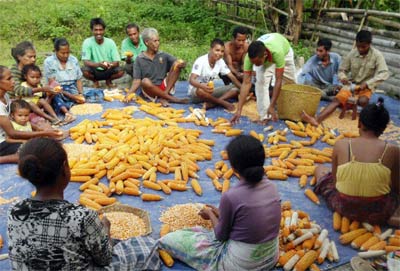
Through five years of on-farm trials supported by the governments of East Timor and Australia using locally-suited crop varieties provided by five centers of the CGIAR-Consortium, small-scale farmers in East Timor learned about and acquired seed of improved varieties of maize and other key food crops, as well as improved cropping practices. The hungry season for the major staple, maize, was significantly reduced among the adopters and, with more recent support from the “Seed of Life” project and East Timor’s Ministry of Agriculture and Fisheries, farming communities are producing improved maize seed to satisfy local demand.
A mountainous nation at the very end of the 4,200 kilometer-long Indonesian Archipelago in the Indian Ocean, East Timor has poor soils and limited irrigation that barely support farming of its staple crops, maize and rice. It has one of the fastest-growing economies in the world, but 80% of East Timor’s working population practices agriculture. The struggles leading up to the country’s independence in 1999 left widespread food insecurity. Rural inhabitants—particularly in the uplands—suffer a several-month-long hungry season, when annual stocks of the staples and of root crops (cassava, sweet potato, taro, arrowroot) run out.
Launched in 2000 with support from the governments of Australia and East Timor, the Seeds of Life initiative organized more than 3,000 on-farm demonstrations in the initial 5 years of the project to raise awareness among farmers about improved varieties and cropping practices for maize, rice, groundnut, sweet potato, and cassava. Through more than 1,000 on-farm trials during 2006-10, East Timor’s Ministry of Agriculture and Fisheries (MAF) found that an improved open-pollinated maize variety “Sele,” derived from CIMMYT breeding programs, yielded nearly 50% more grain on average than traditional varieties. During 2008-11, nearly 28,000 households obtained seed of Sele and by 2010 more than 70% of those families (up from only 58% in 2006-07) were harvesting enough maize grain for their entire year’s food needs. Overall, Seeds of Life’s efforts to identify, multiply, and distribute seed of higher-yielding, more nutritional varieties of the food crops farmers grow have measurably improved the food security and general welfare of participating households.
“A major bottleneck for maize has been the shortage of quality seed of improved varieties,” says Buddhi Kunwar, Informal Seed Production Advisor of MAF who has been working in Seeds of Life. “Despite intensive efforts, the supply of MAF-released Sele seed was only 32 tons in 2011 and 89 tons in 2012, far below the nation’s total maize seed requirement. To address this, we have included community-based seed production as a key part of the Seeds of Life’s most recent phase, which began in 2011 and runs through 2016.”
In community-based seed production, organized groups of farmers operating close to their homes produce, store, and market maize seed, initially with training and other backstopping from MAF or non-government organizations (see the list below). Each group eventually operates on its own, once members gain experience in producing quality seed and marketing or distributing it within the group and their community.
During 2011, more than 700 community-based seed production groups were facilitated by MAF and non-government organizations. Of these, 320 were growing Sele, using 5 kilograms of certified seed they received to sow a 2,000 m2 seed plot. That year 289 groups produced a total of 46 tons of seed, which was stored in airtight steel drums and used to meet the seed requirements of group members and, with the seed left over, for barter or sale.
One problem encountered was grazing animals: these consumed the entire maize seed crops of 31 groups. “During the 2012-13 maize cropping season, MAF and NGO extension officers have selected seed plots that are well protected by fencing in most locations,” says Kunwar, “and a few communities have introduced ‘tara bandu’–a traditional social rule to restrain animals–to protect seed plots.”
In 2012-13 Seeds of Life operates in 11 of East Timor’s 13 districts, including 45 sub-districts and 135 villages. There are 680 community-based seed producer groups supported by MAF extension and another 400 groups supported by non-government organizations. According to Kunwar, Phase 3 of Seeds of Life runs from February 2011 through January 2016 and will support more than 1,000 community seed production groups for subsistence seed production and 50 farmer associations for commercial seed production, covering all 13 districts. The groups produce seed of maize as well as seed of improved varieties of rice and peanuts and cuttings of cassava and sweet potato.
For more information: B.M. Prasanna, Director, Global Maize Program, CIMMYT (b.m.prasanna@cgiar.org), or Buddhi Kunwar, Seeds of Life Program, MAF (buddhi.kunwar@seedsoflifetimor.org)
Australian funding for Seeds of Life comes through the Australian Agency for International Development (AusAID) and ACIAR; it is managed by ACIAR. The Centre for Legumes in Mediterranean Agriculture (CLIMA) within The University of Western Australia coordinates Australian-funded activities. Adapted lines of food crops for on-farm tests were provided by CIMMYT, IRRI, CIP, ICRISAT, and CIAT. Field work has been led by the Ministry of Agriculture and Fisheries (MAF), with facilitation by non-government organizations such as CARE-International, Mercy Corps, Hivos, USC-Canada, World Vision International (WVI), and Catholic Relief Services (CRS).
 Capacity development
Capacity development